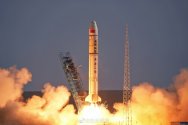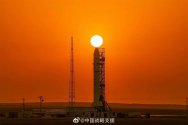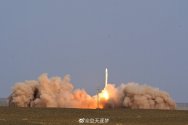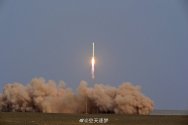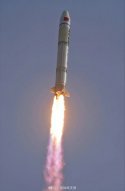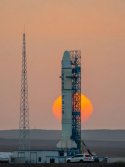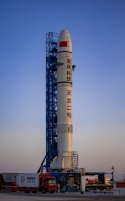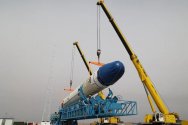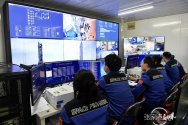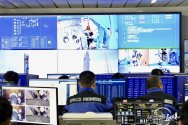You are using an out of date browser. It may not display this or other websites correctly.
You should upgrade or use an alternative browser.
You should upgrade or use an alternative browser.
China's Space Program Thread II
- Thread starter Blitzo
- Start date
by78
General
Tianbing is currently working on the Tianlong-3M (TL-3M) manned intercontinental transport vehicle, which is a VTHL design. The first-stage booster is re-usable and can autonomously return to the launch site or the nearest landing site. The second-stage is the manned spacecraft that can be re-used 30 times, with the passenger cabin having a diameter of 3.8 meters and a length of 11 meters. Payload capacity to LEO is 50 tons, with an intercontinental transport capacity of 30 tons or 100 people.


these are imaging satellites using the synthetic aperture principle, while radar is non-imaging scatterometry. To get 3D imaging information, you have to give up real time information including velocity.Are any of these radar satellites expected to be able to pick up aircraft?
Objects in motion within a SAR scene alter the Doppler frequencies of the returns. Such objects therefore appear in the image at locations offset in the across-range direction by amounts proportional to the range-direction component of their velocity. Road vehicles may be depicted off the roadway and therefore not recognized as road traffic items. Trains appearing away from their tracks are more easily properly recognized by their length parallel to known trackage as well as by the absence of an equal length of railbed signature and of some adjacent terrain, both having been shadowed by the train. While images of moving vessels can be offset from the line of the earlier parts of their wakes, the more recent parts of the wake, which still partake of some of the vessel's motion, appear as curves connecting the vessel image to the relatively quiescent far-aft wake. In such identifiable cases, speed and direction of the moving items can be determined from the amounts of their offsets. The along-track component of a target's motion causes some defocus. Random motions such as that of wind-driven tree foliage, vehicles driven over rough terrain, or humans or other animals walking or running generally render those items not focusable, resulting in blurring or even effective invisibility.
by78
General
High-resolution images of the successful Tianlong-2 (TL-2) launch.
TL-2 is developed by the private launch provider Tianbing Technology. It uses liquid LOX/kerosene propellant, with the kerosene being derived from coal, as opposed to the traditional and more expensive method of refining kerosene from petroleum. TL-2 has a three-stage configuration and has a total length of 32.8 meters, take-off mass of 150 tons, take-off thrust of 190 tons, LEO capacity of two tons, and SSO capacity 1.5 tons.
The successful first flight of TL-2 achieved multiple firsts:
1) The world's first successful maiden launch of a pure liquid launch vehicle developed by a private company.
2) The world's first successful launch using a staged-combustion-cycle LOX/kerosene engine developed by a private company.
3) The world's first successful flight of a launch vehicle using coal-derived kerosene.
4) The first Chinese liquid launch vehicle that does not rely on a launchpad.
5) The first Chinese launch vehicle using 3D-printed high-pressure staged-combustion-cycle engine.
6) The first Chinese launch vehicle using an open-cycle liquid oxygen kerosene rocket engine (YF-102, more on this later).
7) The first Chinese launch vehicle to have a three-engine cluster on the same motor mount.
8) The first Chinese launch vehicle to have an all-aluminum-alloy surface tension propellant tank for orbit attitude and orbit control maneuvers.
9) The first Chinese launch vehicle to re-use rocket fuselage. This is the same fuselage that previously underwent a full-system hot test run).
The first stage of the TL-2 rocket uses three YF-102 engines. YF-102 is China's first open-cycle LOX/Kerosene engine and was developed by the Sixth Academy of CASC. Sourcing off-the-shelf YF-102 engines from CASC was crucial to shortening the development time of the TL-2 rocket (only two and half years). Also symbolically important, YF-102 became the first member of the "Eight Years Nine Engines" cohort to fly into space.





TL-2 is developed by the private launch provider Tianbing Technology. It uses liquid LOX/kerosene propellant, with the kerosene being derived from coal, as opposed to the traditional and more expensive method of refining kerosene from petroleum. TL-2 has a three-stage configuration and has a total length of 32.8 meters, take-off mass of 150 tons, take-off thrust of 190 tons, LEO capacity of two tons, and SSO capacity 1.5 tons.
The successful first flight of TL-2 achieved multiple firsts:
1) The world's first successful maiden launch of a pure liquid launch vehicle developed by a private company.
2) The world's first successful launch using a staged-combustion-cycle LOX/kerosene engine developed by a private company.
3) The world's first successful flight of a launch vehicle using coal-derived kerosene.
4) The first Chinese liquid launch vehicle that does not rely on a launchpad.
5) The first Chinese launch vehicle using 3D-printed high-pressure staged-combustion-cycle engine.
6) The first Chinese launch vehicle using an open-cycle liquid oxygen kerosene rocket engine (YF-102, more on this later).
7) The first Chinese launch vehicle to have a three-engine cluster on the same motor mount.
8) The first Chinese launch vehicle to have an all-aluminum-alloy surface tension propellant tank for orbit attitude and orbit control maneuvers.
9) The first Chinese launch vehicle to re-use rocket fuselage. This is the same fuselage that previously underwent a full-system hot test run).
The first stage of the TL-2 rocket uses three YF-102 engines. YF-102 is China's first open-cycle LOX/Kerosene engine and was developed by the Sixth Academy of CASC. Sourcing off-the-shelf YF-102 engines from CASC was crucial to shortening the development time of the TL-2 rocket (only two and half years). Also symbolically important, YF-102 became the first member of the "Eight Years Nine Engines" cohort to fly into space.





I was wondering if they built the engines themselves. So it's from state agency. Guess it helps them shorten development time and catch up with others who started years before them.The first stage of the TL-2 rocket uses three YF-102 engines. YF-102 is China's first open-cycle LOX/Kerosene engine and was developed by the Sixth Academy of CASC
Does Landspace(I remember reading they are one of the largest and most advanced Private Chinese space launch company) make their own engines or do they also buy them from CASC?
by78
General
I was wondering if they built the engines themselves. So it's from state agency. Guess it helps them shorten development time and catch up with others who started years before them.
Does Landspace(I remember reading they are one of the largest and most advanced Private Chinese space launch company) make their own engines or do they also buy them from CASC?
This is the only instance I can think of where a private company had sourced off-the-shelf engines from another entity.
How fast do you think private rocket companies will ramp up?
Most them are following the chain of solid rocket>liquid small/medium-lift launch vehicle>more capable reusable version of said liquid small/medium-lift launch vehicle>reusable heavy lift- with most of them going for a triple core configuration like the falcon heavy for this. Most of their early rockets are going to be just for testing and to gain experience. Most of them is going for the Spacex model of having a workhorse reusable medium/heavy lift rocket.
Space pioneer has gotten to the 2nd stage, and we won't be seeing much as of the Tianlong-2 launch as the company is going to be racing for the Tianlong-3, a 15 ton to LEO reusable rocket, which is planned for a 2024 launch. Which is really optimistic to me, even an expendable version is going to be very difficult to develop in a year, let alone a reusable version.
I'm guessing a expendable version by 2025 or late 2024, and another year or two to make it reusable, another year or two to optimize the rocket, engines, launch systems, ground operations, recovery, reusability to cut cost and up the launch cadence to the nearly weekly launches of Spacex. If they're developing the heavy lift version at the triple core version at the same time, it should come out around the same time as when they optimize reusability . So all in all, maybe anywhere from 4-8 years to get to the same launch capability and cadence as Spacex's faclon 9 and falcon heavy today?
I'm guessing a similar timeline for most of the private space companies once they have successfully launched their first liquid fueled rocket. 4-8 years from that to Spacex tier weekly Falcon 9 launches. So thoughts? Am I too optimistic? Too negative?
Most them are following the chain of solid rocket>liquid small/medium-lift launch vehicle>more capable reusable version of said liquid small/medium-lift launch vehicle>reusable heavy lift- with most of them going for a triple core configuration like the falcon heavy for this. Most of their early rockets are going to be just for testing and to gain experience. Most of them is going for the Spacex model of having a workhorse reusable medium/heavy lift rocket.
Space pioneer has gotten to the 2nd stage, and we won't be seeing much as of the Tianlong-2 launch as the company is going to be racing for the Tianlong-3, a 15 ton to LEO reusable rocket, which is planned for a 2024 launch. Which is really optimistic to me, even an expendable version is going to be very difficult to develop in a year, let alone a reusable version.
I'm guessing a expendable version by 2025 or late 2024, and another year or two to make it reusable, another year or two to optimize the rocket, engines, launch systems, ground operations, recovery, reusability to cut cost and up the launch cadence to the nearly weekly launches of Spacex. If they're developing the heavy lift version at the triple core version at the same time, it should come out around the same time as when they optimize reusability . So all in all, maybe anywhere from 4-8 years to get to the same launch capability and cadence as Spacex's faclon 9 and falcon heavy today?
I'm guessing a similar timeline for most of the private space companies once they have successfully launched their first liquid fueled rocket. 4-8 years from that to Spacex tier weekly Falcon 9 launches. So thoughts? Am I too optimistic? Too negative?

